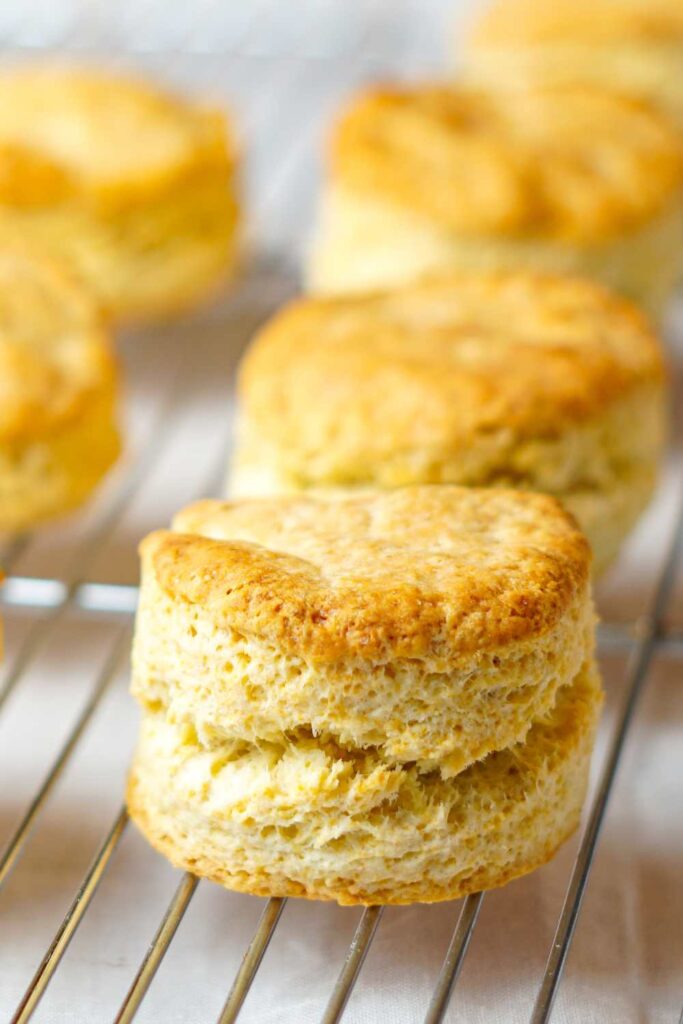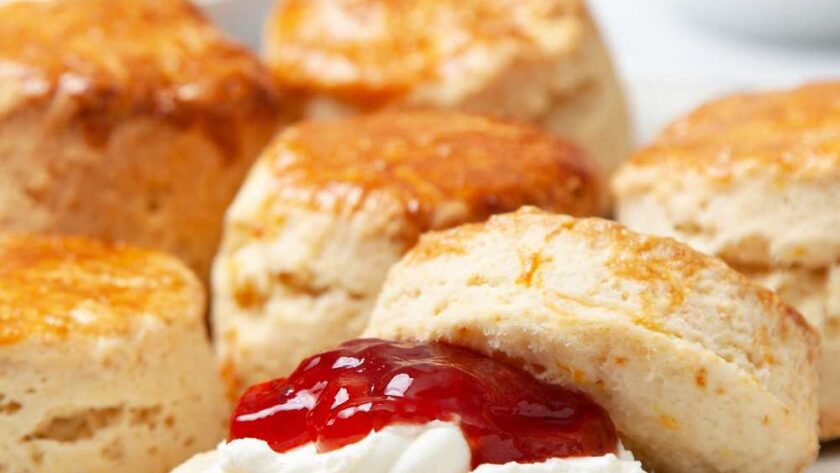I still remember the first time I had to bake gluten-free scones — not by choice, mind you. My niece had just been diagnosed with coeliac disease, and there I was, clutching a box of unfamiliar flour and eyeing xanthan gum like it was some sort of science experiment. I muttered, “Mary Berry wouldn’t stand for this,” but then I thought… well, what if she would?
That’s where this Mary Berry Gluten Free Scones recipe comes in. It’s every bit as light, crumbly, and utterly British as you’d hope, just without the gluten. Whether you’re gluten-free yourself, baking for someone who is, or just up for a challenge, this one’s worth the oven time.
Ingredients List
- 340g (2½ cups) gluten-free self-raising flour — Use one with added rice or maize starch for that fluffy lift.
- 1 tsp gluten-free baking powder
- ¼ tsp xanthan gum — Key for holding everything together.
- 85g (⅔ cup minus 1 tsp) cold butter — Or Stork hard margarine for a dairy-free version.
- 4 tbsp caster sugar — Adds gentle sweetness; feel free to dial it down.
- 175ml (¾ cup minus 1 tsp) milk — Use dairy-free if needed. Oat milk works beautifully here.
- 3 tsp lemon juice — Helps activate the baking powder and adds brightness.
- 1½ tsp vanilla extract
- 1 egg, beaten — Or use almond milk for brushing if you’re going fully vegan.
(I didn’t say anything about the vanilla, did I? See, even I forget sometimes. Blame the memories.)
How To Make It (Instructions)
- Preheat your oven to 220°C (200°C fan) / 425°F and line a baking tray with parchment.
(I always forget to line it until my hands are doughy. Don’t be me.) - In a large bowl, sift together the gluten-free self-raising flour, baking powder, and xanthan gum.
- Add the cold butter (or margarine) and rub it in with your fingertips until the mix resembles breadcrumbs.
- Stir in the sugar and mix gently.
- Warm the milk slightly, then stir in lemon juice and vanilla extract. Let it sit a moment — it’ll curdle slightly and mimic buttermilk.
- Pop the baking sheet into the oven to preheat — this helps the bottoms of your scones crisp up nicely.
- Make a well in your flour mixture, pour in the milk mixture, and use a butter knife to gently bring the dough together.
- Tip the dough onto a floured surface (gluten-free flour again!) and pat it to 3.5–4.5cm thickness. Not thinner — they need height to rise!
- Cut out rounds with a 5cm cutter. Don’t twist the cutter; it ruins the rise.
- Brush the tops with beaten egg or almond milk.
- Bake for 12–15 minutes until golden and risen. Cool slightly on a wire rack — but these are best served warm, of course.

Common Mistakes
Why are my scones so crumbly?
Too little xanthan gum or too much flour. Gluten-free dough needs just enough structure — not a grain more.
Why didn’t they rise properly?
Either your dough was too thin, or your oven wasn’t hot enough. Also, don’t over-handle the dough — it should just come together.
Can I skip preheating the tray?
Technically yes, but you’ll miss that lovely golden underside. I did it once when rushing, and regretted it.
Why do they taste flat?
Could be the flour blend. Some gluten-free flours are blander. Add a bit more vanilla or a pinch of salt to lift it.
Storage And Reheating Tips
Room Temp: Keep them in an airtight tin for 1–2 days max. They dry quickly.
Freezer: Freeze on the day of baking. Wrap each scone individually in cling film, then store in a freezer-safe bag for up to 3 months.
Reheat in Oven: 150°C / 300°F for 5–8 minutes — brings them right back to life.
Microwave: 20–30 seconds wrapped in a damp paper towel. Quicker, but softer texture.
What To Serve With It
- Clotted cream & strawberry jam — The gold standard. Don’t fight it.
- Whipped coconut cream & fresh berries — A vegan-friendly dream.
- Lemon curd & dairy-free yoghurt — For a zingy, refreshing twist.
Hot cuppa tea alongside, of course. Preferably Earl Grey, if you’re asking me.
FAQ Section
Can I make these vegan as well as gluten-free?
Yes! Use dairy-free margarine, a plant milk like oat or almond, and skip the egg wash in favour of almond milk.
Do I need xanthan gum in gluten-free scones?
It helps bind the dough. Without it, the texture is more crumbly and less scone-like. You can substitute with guar gum or psyllium husk, though.
How thick should the dough be for gluten-free scones?
3.5–4.5cm is the sweet spot. Too thin, and they won’t rise properly.
Can I use plain gluten-free flour instead of self-raising?
You can, but you’ll need to add extra baking powder — about 2 tsp per 250g of flour.
More Recipes:
- Mary Berry Gluten Free Victoria Sponge
- Mary Berry Lemon And Pistachio Cake
- Mary Berry Peppermint Slice

Mary Berry Gluten Free Scones
Description
Light, fluffy, and gluten-free, these scones are perfect for tea time or a quick sweet treat.
Ingredients
Instructions
- Serve warm or freeze for later.
- Preheat oven to 220°C (200°C fan) / 425°F. Line a baking sheet with parchment.
- Sift flour, baking powder, and xanthan gum into a bowl.
- Rub in butter/margarine until the mix looks like breadcrumbs.
- Stir in sugar.
- Warm the milk, then add lemon juice and vanilla. Let sit briefly.
- Place baking sheet in oven to preheat.
- Add milk mixture to dry ingredients and mix to form dough.
- Pat dough to 3.5–4.5cm thickness on floured surface. Cut out rounds.
- Brush tops with egg or almond milk.
- Bake 12–15 mins until golden.

